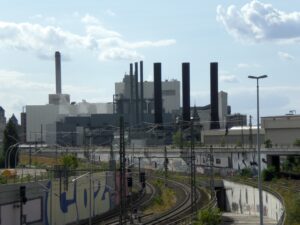
Moabit power and heat plant (currently mostly coal fired, but with plans for a new biomass unit), Photo: Wikimedia
Joint briefing by Biofuelwatch and the Environmental Paper Network’s Forests, Climate and Biomass Working Group
Updated April 2024
Click here to download the briefing
Click here to read a joint letter by 16 environmental organisations from 6 countries sent to Vattenfall on 13th April 2022.
Summary:
Energy company Vattenfall is fully owned by the Swedish state. For many years, until 2015, Vattenfall counted as one of the EU’s top three fossil fuel CO2 emitters. In 2018, the
company rebranded itself and adopted the motto “fossil free living within one generation”. In 2016, Vattenfall sold its lignite mines and power plants in Germany. Since 2017, Vattenfall has closed four of its six coal power plants and decided to stop burning coal entirely in 2030 (later than the coal phaseout date of many European countries), and the company has scaled up its investment in wind energy. However, Vattenfall retains a large fossil fuel capacity (4.8 GW electricity and 14.2 MW heat). Most of this is fossil gas. Furthermore, it has been investing in burning more wood for energy, mainly for heat, an energy source the company plans to expand significantly in future. This is the focus of this briefing.
